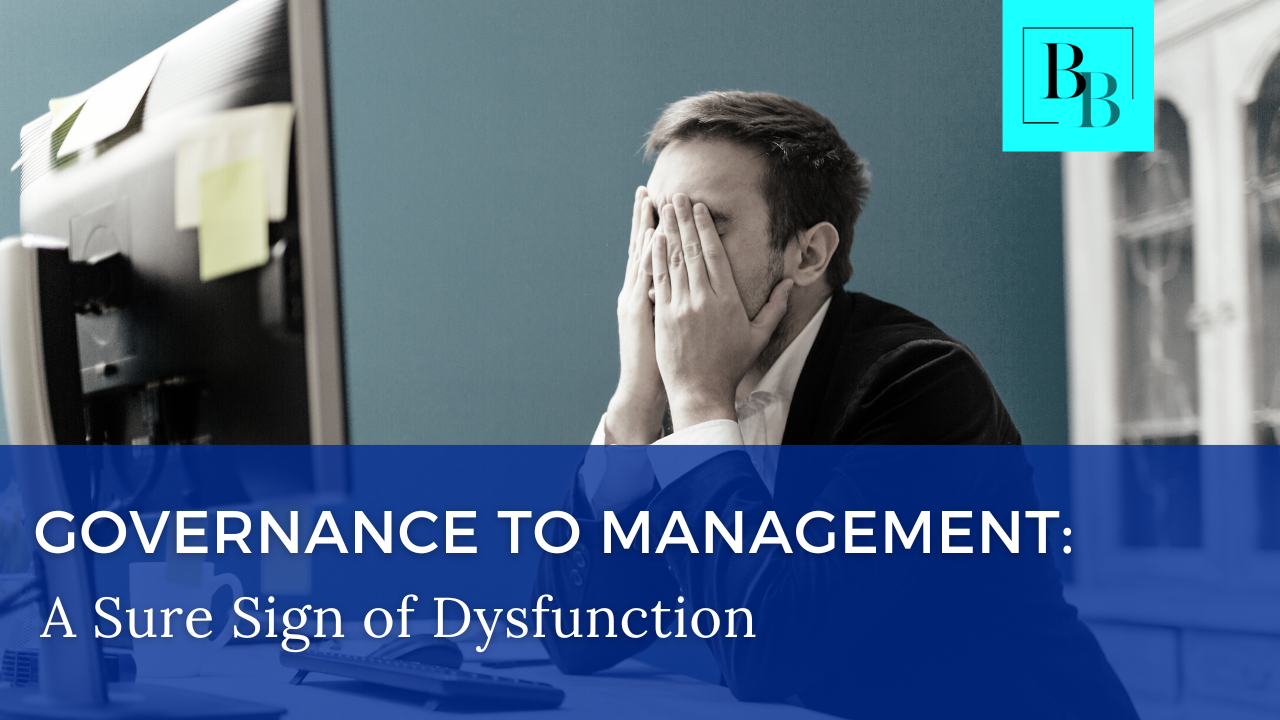Governance to Management: A Sure Sign of Dysfunction
Apr 03, 2023
Let’s face it. We’ve all been there. Stepping a bit out of bounds. Crossing from policy to management, because it’s a bit easier, a bit more concrete and a bit more fun. We know it’s not our role and responsibilities, but we do I anyway. And then it can all go off the rails… Here’s one story.
A few months ago a public library board chair made this statement:
A wave of change is coming and employees can learn to swim or not. (attributed to Elmwood Public Library Board President Chris Pesko).
It would appear that the board and the director had a series of disagreements about the role of the board vis-à-vis management. These are documented. The director left a while ago. A story ran a couple of weeks ago in Book Riot as: “Noting “changed complexion of staff” Elmwood Park Public Library Board takes over: A case study in library de-professionalization.”
Now it could very well be a case of de-professionalization, but the root cause to me is a board not recognizing its appropriate role and responsibilities, indeed not recognizing that its power rests in its role as leadership through effective governance. The story notes that the December, 2022 minutes of the Elmwood Board meeting (IL) are unlike any public library meeting minutes you’ve likely seen. Though public comment was not long, the minutes indicate extreme discontent happening within the walls of the library.
And perhaps, according to the story, “the library’s advertising over 1/5 of their positions as open–all of which are full-time, professional and managerial positions–also sheds light on what appears to be a Board eager to deprofessionalize the facility while implementing an anti-DEI, anti-inclusive culture in order to “align” with the needs of the community.”
Share this article with your friends and colleagues!
At the same meeting, the Board made it clear any and all communication with the library needed to go through them first. One should specify that this includes the Chief Executive Officer communicating with staff. The Board also addressed hiring for positions within the library: the Board wanted to see the resumes of every applicant hired for a position, a list of every candidate who was interviewed, and notes as to why they were not hired.
Way, way, over the line.
How does a Board hold a Chief Executive Officer or Executive Director accountable when they are doing the very job for which they hired the person?
And the selection and engagement of the new CEO was “fraught” to say the least. A case study of bad practice in and of itself. The article casts aspersions and assigns motive but at the least, a committee should be established, the committee should interview each candidate, there should be more engagement than one interview by zoom and the chair should not choose and ask for immediate ratification. There appeared to be no approved policy or process for the new appointment. Among many other transgressions.
But this is not really the issue.
If the Board was so desperately unhappy with the previous director, what was the process for improvement? Was there a board-approved clear job description and annual work plan? A fair, objective and transparent process for review and evaluation? An improvement plan with support? Apparently not. And the Board chair appears to have the power and support of the Board to act as Chair and CEO. If the article is accurate, there are no conflict-of-interest policies, or at least they were not followed.
So, if the Board is playing in the weeds who is doing the Board’s job? Setting strategic directions on behalf of the community, through a process of engagement. Approving policies to guide the Board and the Chief Executive Officer Developing a strong partnership with the CEO. Assuring sustainable resources to achieve the mission. Monitoring and auditing finances and services according to stated criteria. This is an elected board but it really makes no difference.
If you want real power, do your job as community leaders, not the job of a CEO or Executive Director who has appropriate managerial and leadership experience as well as deep industry knowledge.
What are your main “pain points” dealing with roles and responsibilities?
What advice would be most helpful to you?
And we always assume that you are asking for a friend!
Get in touch. We’ll address your questions and concerns in an upcoming blog post.
Looking for Ways to Better CEO and Board Relations?
Online Board Improvement Programs with Ken Haycock
The Board Member 101:
Your accelerated path to competence and confidence.

In this one-month course, you will move from feeling reticent and tentative to competent and confident, asking good questions and making great contributions. The course complements and reinforces your on-site orientation and opens new channels of communication and discussion. Four weeks. Two brief video lessons (watch at your convenience) per week plus downloadable handouts. 30-day money-back guarantee.
The Board Leader Academy:
A step-by-step guide to higher performance and impact.
 Our spotlight course is designed for CEOs/Executive Directors, Board Chairs, and those who are interested in leadership positions on not-for-profit, for-impact boards. Six weeks. Three brief video lessons with handouts per week (watch at your convenience) plus additional downloadable resources. 30-day money-back guarantee.
Our spotlight course is designed for CEOs/Executive Directors, Board Chairs, and those who are interested in leadership positions on not-for-profit, for-impact boards. Six weeks. Three brief video lessons with handouts per week (watch at your convenience) plus additional downloadable resources. 30-day money-back guarantee.
P.S. May I ask a tiny favour? Would you mind sharing this blog with one person? I would love it. You can post the links in your Facebook Groups, LinkedIn or even send an email.

